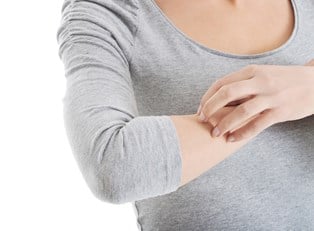Atopic dermatitis, which is a form of eczema, is condition marked by persistent, itchy rashes that occur due to the skin’s inability to properly retain moisture. While this condition is not contagious, it is still quite prevalent—affecting roughly 10% of all Americans and up to 20% of the global population.
Atopic dermatitis symptoms can range from virtually unnoticeable to severe, and often times this is dependent on a person’s access to quality treatment. This condition is not life-threatening but can nonetheless negatively impact a patient’s quality of living because of its uncomfortable nature and the emotional stress it can cause. The following is a short overview of atopic dermatitis—including its symptoms, causes, diagnosis, and treatments.
Atopic Dermatitis Symptoms
The most prevalent symptom experienced by atopic dermatitis patients is itching. This is typically severe and persistent, and over time it leads to rashes. For the most part, these rashes are dry, scaly, and red. However, if patients scratch skin that is infected, their rashes may begin to develop pockets of fluid that have the potential to ooze—although these typically clear up quickly with treatment. Rashes that persist for longer periods of time may become tougher and thicker as patients continue to scratch them.
It’s possible to limit the length and severity of an atopic dermatitis outbreak, but that requires patients to avoid scratching their rashes. However, considering the intensity of the itching, this is sometimes not a possibility for all people.
Atopic Dermatitis Causes
The underlying cause of atopic dermatitis is still unknown. However, people with a family history of the condition are more likely to develop it than those who don’t, so this may be an indication that it is at least somewhat genetic in nature.
However, it is possible to pinpoint environmental triggers that can cause rash outbreaks in people with atopic dermatitis. Some of the most common ones include household allergens, such as dust, mold, pollen, or dander. In addition to these, cold weather, certain cleaning products, stress, and food allergies may also spur on an outbreak.
Atopic Dermatitis Diagnosis
Diagnosing this condition is quite easy, as its symptoms are clearly and visibly present. However, doctors may recommend a skin biopsy to rule out any other similar conditions, such as psoriasis.
Atopic Dermatitis Treatments
There is currently no cure for atopic dermatitis. Thankfully though, with proper treatment patients can minimize or even eliminate their symptoms for long periods of time.
For people with only mild cases of the condition, over-the-counter moisturizing lotions may be enough to keep outbreaks under control. Additionally, discovering and avoiding environmental triggers may also make stronger, medical treatments unnecessary.
If these fail to work, doctors may then recommend antihistamines to reduce itching. These can be found in numerous over-the-counter products such as Benadryl and Zyrtec. While medications such as these won’t eliminate rashes, they can help keep mild breakouts from turning into severe ones by reducing the compulsion to scratch. Antihistamines may be used in conjunction with topical creams containing hydrocortisone, which helps to reduce itching and inflammation.
If this next level of treatment proves to be ineffective, doctors may prescribe patients corticosteroids. This class of steroids is similar to hydrocortisone but more powerful and should only be used for short periods of time, as it can lead to thinning of the skin, infection, and stretch marks.
In addition to addressing the symptoms, treatment for atopic dermatitis may also include counseling or some other form of therapy, especially for younger people. This condition is highly visible and can be embarrassing for some, and counseling can help patients work through the feelings of stress or shame they experience when suffering from an outbreak.



